First Day of Future Craft Notes
In cleaning up, I found my notes from the first day of Future Craft. Since they are on a random loose leaf sheet of paper, I have no good way (nor need) to keep it, but a couple quotes stood out, and I wanted to capture them before recycling the paper, since they affected me at the time, and still do:
“Designers are also consumers of materials – consumers with the power to shift trends and practices.”
“The tools available to designers influences the products that are produced.”
“What tools are needed to design the society we want?”
“Labor and social dynamics impact design!”
Worth contemplating for a bit, then tucking away to discover again later.
Second Skin Pictures
Pictures of Brooke wearing the ‘mood dress’. For more information, see my previous posts.
Second Skin
Goal:
To explore the definition and purpose of modesty and privacy by visibly displaying the physiological signals projected by our skin, while still adhering to social acceptability in both modesty and fashion.
Inspiration: See my previous post.
A blush (face region) or flush (the rest of the body) is the slight to sever reddening of the skin which occurs due to blood vessels near the skin dilating, allowing more blood to come to the surface of the body and therefore more heat to radiate form the body. The causes of blushing and flushing are varied, but can often be due to involuntary reactions For example, people blush and flush when they are sexually aroused, angry, or embarrassed. Though involuntary, these bodily signals do seem to be direct, purposeful responses meant to communicate with those around us. For example, studies have shown that children do not start blushing until they are about school age, when they start interacting in social situations. Additionally, Dr. Peter D. Drummond has done studies that demonstrate that people blush more on the side of the body that other people can see. Most interesting are studies that show people who blush are better liked and accepted. It seems that, contrary to what you might think, showing your inner emotions is a good thing. Whether it’s warning those around you that you are angry or displaying that you know you did wrong and feel bad about it.
Mechanism:
 Though it is hard to replicate these slight skin color changes on cloth, the high correlation between deeper blushing (more red) and higher heat – both results of increased blood flow – mean that mood rings aren’t that far off. Mood rings are made of thermochromic liquid crystals that reflect different colors at different temperatures. Though it is hard to map a specific mood to a specific temperature (color), material that changes color due to more blood flow (higher temperature) acts very similarly to how skin changes color due to more blood flow. Though crude, creating “mood clothing” is a low tech, time conserving and cost saving way to try to display the skin’s signals on the cloth that covers the skin.
Though it is hard to replicate these slight skin color changes on cloth, the high correlation between deeper blushing (more red) and higher heat – both results of increased blood flow – mean that mood rings aren’t that far off. Mood rings are made of thermochromic liquid crystals that reflect different colors at different temperatures. Though it is hard to map a specific mood to a specific temperature (color), material that changes color due to more blood flow (higher temperature) acts very similarly to how skin changes color due to more blood flow. Though crude, creating “mood clothing” is a low tech, time conserving and cost saving way to try to display the skin’s signals on the cloth that covers the skin.
Design:
Once a re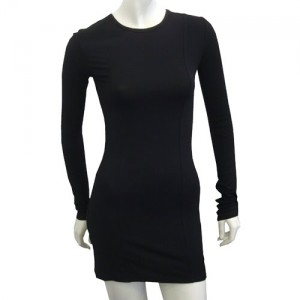 asonable method was determined (thermochromic liquid crystals), the next step was to find liquid crystals and an adequate clothing item to apply them to.
asonable method was determined (thermochromic liquid crystals), the next step was to find liquid crystals and an adequate clothing item to apply them to.
Since the goal of this project was to maintain modesty, while still being somewhat fashionable, clothing that was decently concealing was needed. At the same time, it had to be tight enough to allow sufficient heat transfer between the skin and the clothing. For these reasons, a form-fitting black dress of moderate length and long sleeves was chosen. A longer dress could not have been form fitting around the legs and still allowed movement, while an all black body suit would not have been very fashionable. Additonally, the design of the applied liquid crystals needed to be fashionable, but also tasteful. Covering the dress in luqid crystals would be tacky and too revealing. A design was chosen to conveniently leave areas with limited skin contact, like cleavage, belly button and groin areas.
Construction:
First, the dress was marked with the areas to avoid, then the luqid crystal sheets were cut to size and applied with double sided tape. I used a template and created a grid using tape to help keep the pattern aligned. After placing all the squares of liquid crystals, I removed the templates and grid.
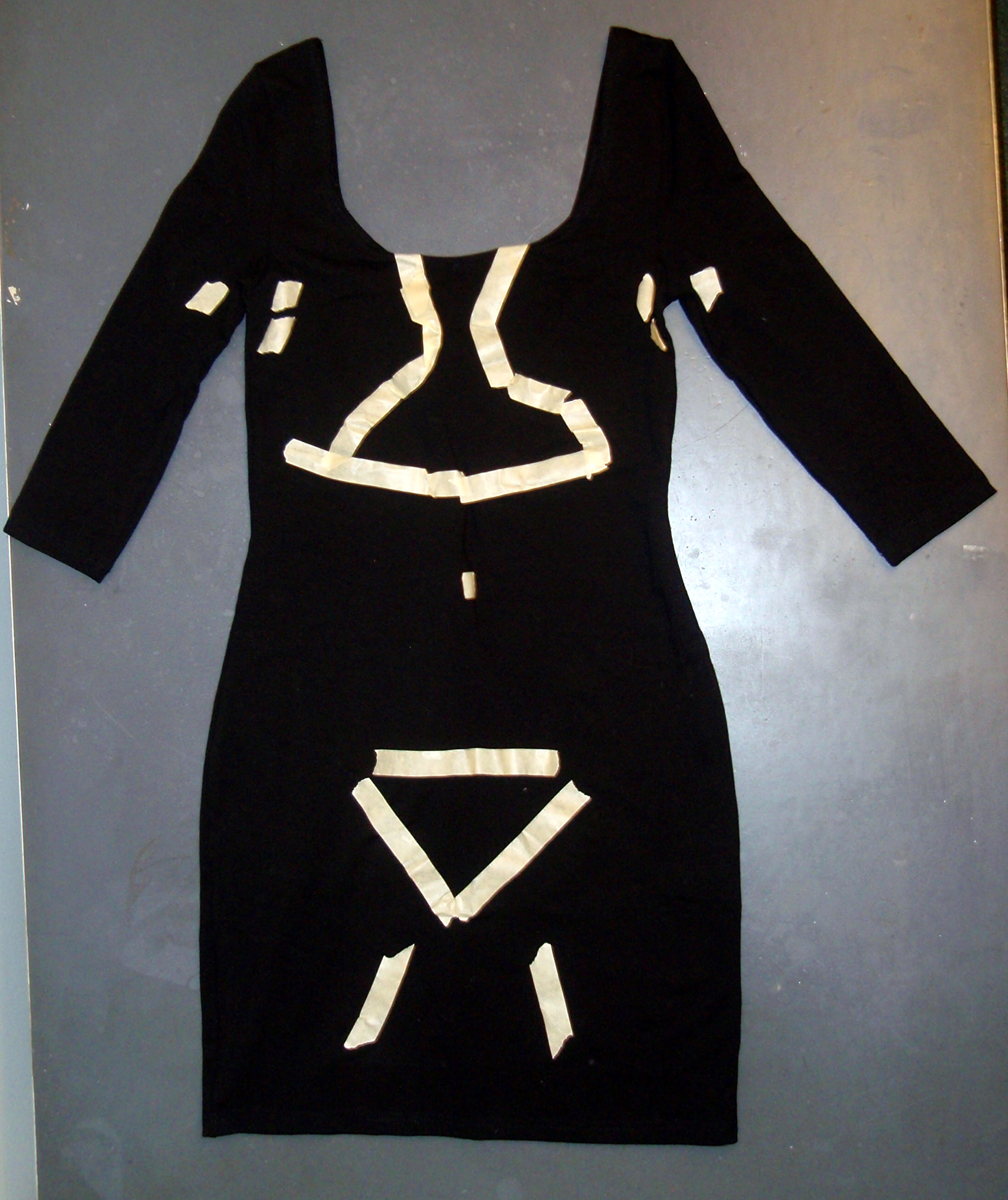
Taping off areas to avoid.

Cutting the liquid crystal sheets into 1/2" strips.

Laying out the templates and grid.
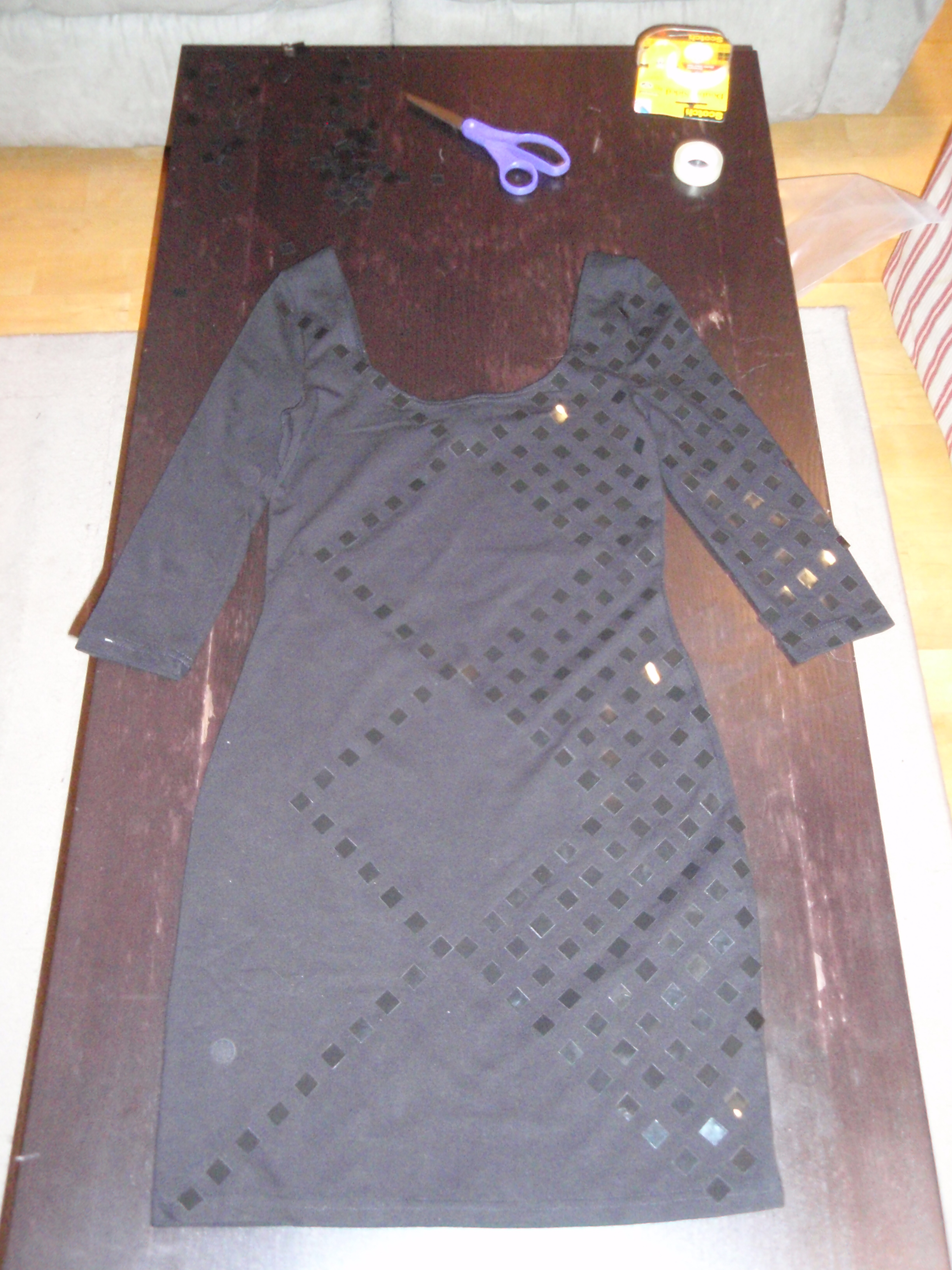
Done!
You can purchase thermochromic liquid crystals in sheets or as paints. Some suppliers are:
Note that they can be designed for various temperature ranges. Since this project was looking at the skin temperature in the core of the body, liquid crystals active over 30-35°C were selected. If you are looking for liquid crystals to be active by touching them with your hands, a range of 25-30°C may be more appropriate. Also, since a dynamic color range was desired, liquid crystals were chosen. If you only desire a single color change at a specific temperature, thermochromic ink can be used instead. This is how hypercolor (http://en.wikipedia.org/wiki/Hypercolor ) t-shirts work.
Results: And here it is! Check out Brooke’s blog for her experience wearing the dress for a day.
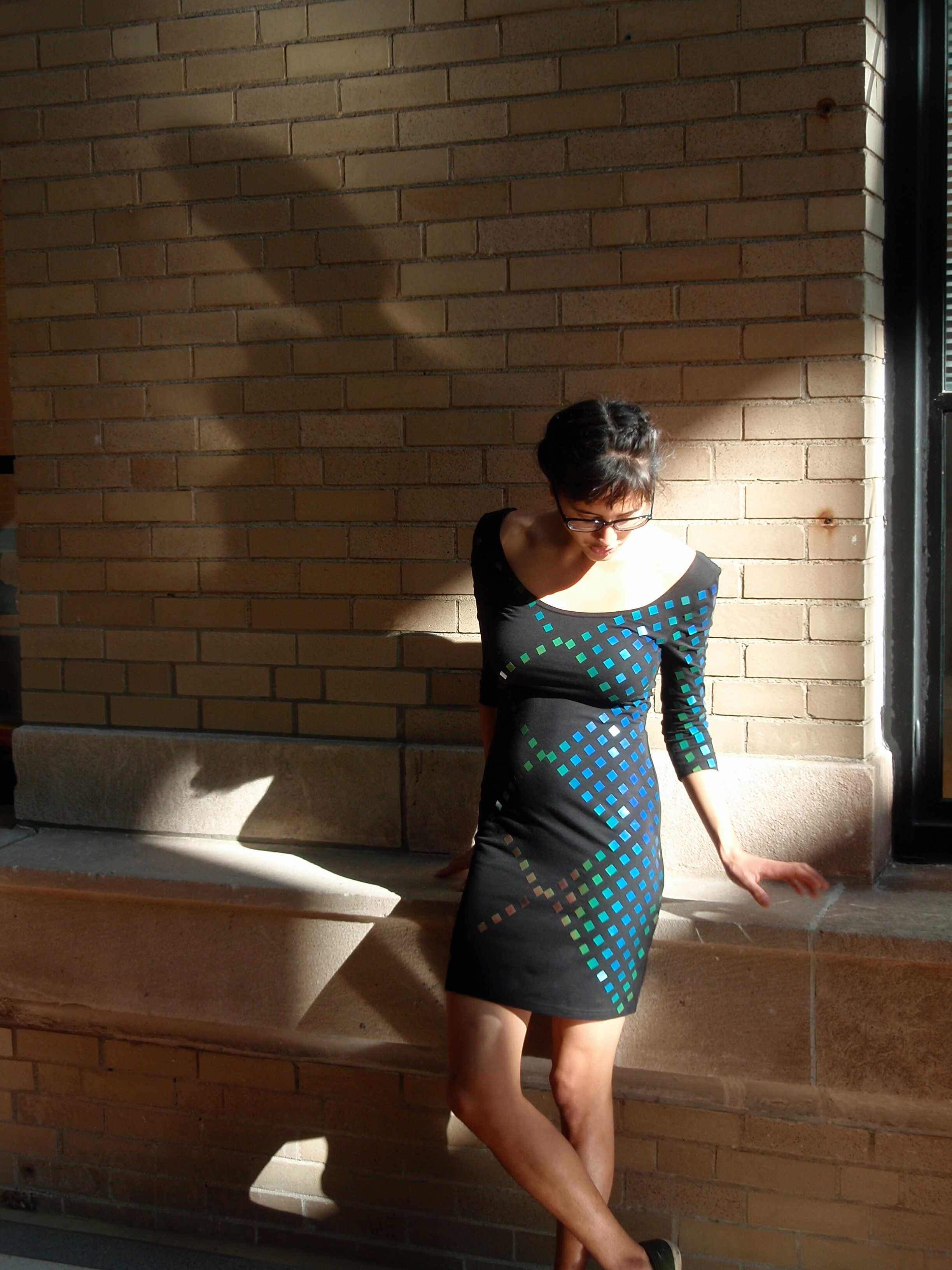
More info on blushing, thermochromic liquid crystals, skin temperature and other such things:
Mark Changizi’s article on vision evolution
Why Do We Blush? (http://www.thercg.org/youth/odds/0402-wdwb.html)
NYT Article on Blushing (http://www.nytimes.com/2009/06/02/health/02mind.html)
How Stuff Works article on blushing (http://health.howstuffworks.com/blush1.htm)
Handbook of Thermochromic Liquid Crystal Tehcnology (http://www.davisliquidcrystals.com/downloads/RT006%20randtk_TLC_Handbook.pdf)
Temperature of Healthy Human Skin (http://hypertextbook.com/facts/2001/AbantyFarzana.shtml)
Re-Thinking Modesty
I read an interesting article by Mark Changizi (the author of a new book about our understanding of vision, The Vision Revolution) that explained his theory that humans’ unique color vision evolved so that we could better read the physiological signals our body produced. He posits that the reason humans do not have hair all over our bodies in the way that other primates do is that we use our entire body to “signal” – blushing, anger, arousal, fear, etc.
What I found interesting about this is that over time, modesty and society caused people to cover up the exact skin that we evolved hairlessness and color vision to see, at least according to Mr. Changizi. This made me think about how we could *use* clothing to project the physiological signals that our skin sends, while still bowing to social (and practical!) issues of modesty and protection?
Imagine clothing that mimicked the body’s reactions underneath it: goosebumps, blushes, flushes… Not the static imperfections – no sunburn, or freckles or pimples or moles or unshaved legs – only the dynamic ‘body language’ that happens when our body reactions to emotional states.
By more prominently displaying this relevant information which is usually more subtle (and often hidden entirely!), the wearer (and on-looker!) is forced to re-evaluate the definition and goal of modesty. Is it the skin itself that is so tantalizing? Or the messages it sends? The garment also brings up issues of privacy intrusion. When people cover their bodies, is it the shape (cologne, dimples, and fat, oh no!), base skin tone (no time to fake tan this week…), and flaws (no time to shave, annoying mole, acne break out, etc) that they want to hide, or is our fear of mind reading in the wake of Minority Report another reason we choose to conceal our skin?
Would humans be more empathetic if it was easier to discern the emotional state of those around them? Would we learn how to better control our emotions if they were on constant display? Or would manipulation and exploitation be made that much easier? Would the thrill of the chase be removed if you could read your love-interest’s emotional state and know (maybe before they consciously did!) that he or she was attracted to you?
Now, think if this piece of clothing, that projects underlying skin signals, was a burka.

Inspiration for the practical application.
Practical Implementation:
I think this could be accomplished using thermochromatic liquid crystals (think: mood rings), which, while not exactly mimicking the skin’s subtle color changes due to blood physiology (oxygenation and concentration), do change color due to a person’s skin temperature, which is closely related to blood concentration. Though a burka is sadly too lose to do this well, a tight fitting, realtively modest black dress would work. That way it can be fashionable, still maintain goals of modesty, yet allow skin temperature monitoring by liquid crystals on the dress.


Bigger, Slower, Cheaper: Detechnologizing Products

An example of a child's See-and-Say Toy.
In our last class, Rich Fletcher talked to us about de-technologization (is that even a word?). The point being, that Moore’s law, though useful and good in some respects, can be detrimental in other ways. That the push for smaller, faster, cutting edge (read: “more expensive”) leaves a lot to be desired. Most notably in developing nations who can’t afford (and don’t need!) the latest-greatest but could benefit substantially from an affordable alternative. But even first world citizens feel the curse of technology. I’m too young to remember, but my older and wiser family members talk fondly of the days when they could fix their own cars (or insert another piece of common household appliances)and bemoan the fact that now the task has become so complex that only the dealer has the required tools. So the solution, or so Mr. Fletcher proposes, is to rethink design to be bigger, slower, and cheaper. One of the projects he presented involved bringing internet to remote places. The catch is that is wasn’t real time. It was “slower” and it was a ton “cheaper”. But it was also better than no internet. Another example he talked about is the design of children’s toys. They are incredibly elegant in their simplicity, durability, and human-scaled-ness. It was inspiring to look at the workings of a See-and-Say toy that used only simple mechanical process to say the words corresponding to pictures.
“Bigger, cheaper, slower” is by no means a new concept. Below are some interesting, recent examples of “de-technologized” products:
 Home Voltage Optimization – Cheaper!
Home Voltage Optimization – Cheaper!
I know £299 doesn’t sounds cheap, but this technology, which helps reduce and stabilize electricity usage and therefor cuts energy costs and carbon emissions, has traditionally been sized and priced solely for industrial use. This is the first time that the technology has been reduced both in size and cost to enable the average consumer to take advantage of it at home, and that’s pretty exciting.
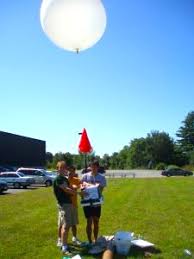 Students Take Pictures of Earth From Space – Cheaper! Slower!
Students Take Pictures of Earth From Space – Cheaper! Slower!
For under $200, students at MIT and more recently in Australia, sent a digital camera into space on a balloon and took stunning pictures of Earth. In the past, only companies or government agencies with lots of money were able to accomplish such a feat. Granted, they didn’t stream the pics back in real time, but who cares?
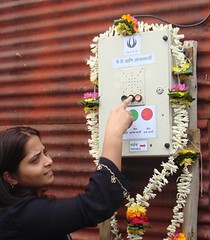 Question Box – Cheaper! Slower!
Question Box – Cheaper! Slower!
In the them of bringing internet to distant places, this project brings the power of Google to villages without internet, through an old-fashioned intermediary, the call box. People with a question can press a button and someone on the other end of the phone, sitting at an internet-connected computer, looks up the answer for them. It’s such a simple solution to the hard “last mile” (or last 100 miles) problem.
Though these examples are encouraging and show that people still appreciate a simple, elegant design that gets the job done, the main push still seems to be turning to technology to solve all of our problems. One recent trend which amuses me is the apparent need to use technology and on-line social networks to connect with people who live and work in the same physical location as you (whether that is the same city, the same neighborhood, or the same building!).
It appears the progression went like this: Back in the old days, people could only talk face-to-face, but the use of smoke signals and semaphore show that people quickly realized the benefit of long distance communication. Speed through telegrams and the telephone to the internet and appreciating being connected to loved ones who are far away. That’s great! But the backlash is setting in, people realize they spend more time “connecting” to people on-line and that traditional, location-based interactions are lacking.
Technology to the rescue! Now you can use Stackd to meet people who work in your office building or join Facebook neighborhoods to find out who lives near you and what’s going on at the local park. Though I do think it is great that these tools encourage actual interaction, it seems kinda ironic that in order to use them, you must be on your computer. What does it say about our society that we can’t even say “Hi!” the person we ride in the elevator with, but instead rely on better technology to facilitate such a traditionally simple and tech free encounter?
In order to de-technologize what has become the convoluted way people interact while in close proximity to each other, I would like to re-introduce the tin can phone!




 Picasa
Picasa Twitter
Twitter LinkedIn
LinkedIn Flickr
Flickr